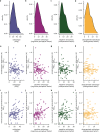The positive dimension of schizotypy is associated with a reduced attenuation and precision of self-generated touch
- PMID: 35854009
- PMCID: PMC9261081
- DOI: 10.1038/s41537-022-00264-6
The positive dimension of schizotypy is associated with a reduced attenuation and precision of self-generated touch
Abstract
The brain predicts the sensory consequences of our movements and uses these predictions to attenuate the perception of self-generated sensations. Accordingly, self-generated touch feels weaker than an externally generated touch of identical intensity. In schizophrenia, this somatosensory attenuation is substantially reduced, suggesting that patients with positive symptoms fail to accurately predict and process self-generated touch. If an impaired prediction underlies the positive symptoms of schizophrenia, then a similar impairment should exist in healthy nonclinical individuals with high positive schizotypal traits. One hundred healthy participants (53 female), assessed for schizotypal traits, underwent a well-established psychophysics force discrimination task to quantify how they perceived self-generated and externally generated touch. The perceived intensity of tactile stimuli delivered to their left index finger (magnitude) and the ability to discriminate the stimuli (precision) was measured. We observed that higher positive schizotypal traits were associated with reduced somatosensory attenuation and poorer somatosensory precision of self-generated touch, both when treating schizotypy as a continuous or categorical variable. These effects were specific to positive schizotypy and were not observed for the negative or disorganized dimensions of schizotypy. The results suggest that positive schizotypal traits are associated with a reduced ability to predict and process self-generated touch. Given that the positive dimension of schizotypy represents the analogue of positive psychotic symptoms of schizophrenia, deficits in processing self-generated tactile information could indicate increased liability to schizophrenia.
© 2022. The Author(s).
Conflict of interest statement
The authors declare no competing interests.
Figures



Similar articles
-
Aging exerts a limited influence on the perception of self-generated and externally generated touch.J Neurophysiol. 2023 Oct 1;130(4):871-882. doi: 10.1152/jn.00145.2023. Epub 2023 Aug 23. J Neurophysiol. 2023. PMID: 37609705 Free PMC article.
-
Functional Connectivity between the Cerebellum and Somatosensory Areas Implements the Attenuation of Self-Generated Touch.J Neurosci. 2020 Jan 22;40(4):894-906. doi: 10.1523/JNEUROSCI.1732-19.2019. Epub 2019 Dec 6. J Neurosci. 2020. PMID: 31811029 Free PMC article.
-
Brief Temporal Perturbations in Somatosensory Reafference Disrupt Perceptual and Neural Attenuation and Increase Supplementary Motor Area-Cerebellar Connectivity.J Neurosci. 2023 Jul 12;43(28):5251-5263. doi: 10.1523/JNEUROSCI.1743-22.2023. Epub 2023 Jun 20. J Neurosci. 2023. PMID: 37339879 Free PMC article.
-
[Theory of mind and schizotypy: A review].Encephale. 2021 Jun;47(3):254-262. doi: 10.1016/j.encep.2020.10.007. Epub 2021 Feb 26. Encephale. 2021. PMID: 33648750 Review. French.
-
Inhibitory deficits in prepulse inhibition, sensory gating, and antisaccade eye movement in schizotypy.Int J Psychophysiol. 2017 Apr;114:47-54. doi: 10.1016/j.ijpsycho.2017.02.003. Epub 2017 Feb 8. Int J Psychophysiol. 2017. PMID: 28189549 Review.
Cited by
-
Action does not enhance but attenuates predicted touch.Elife. 2023 Dec 15;12:e90912. doi: 10.7554/eLife.90912. Elife. 2023. PMID: 38099521 Free PMC article.
-
Predictive attenuation of touch and tactile gating are distinct perceptual phenomena.iScience. 2022 Mar 14;25(4):104077. doi: 10.1016/j.isci.2022.104077. eCollection 2022 Apr 15. iScience. 2022. PMID: 35372807 Free PMC article.
-
The extraordinary enigma of ordinary tickle behavior: Why gargalesis still puzzles neuroscience.Sci Adv. 2025 May 23;11(21):eadt0350. doi: 10.1126/sciadv.adt0350. Epub 2025 May 23. Sci Adv. 2025. PMID: 40408489 Free PMC article. Review.
-
Aging exerts a limited influence on the perception of self-generated and externally generated touch.J Neurophysiol. 2023 Oct 1;130(4):871-882. doi: 10.1152/jn.00145.2023. Epub 2023 Aug 23. J Neurophysiol. 2023. PMID: 37609705 Free PMC article.
-
Predictions of bimanual self-touch determine the temporal tuning of somatosensory perception.iScience. 2024 Dec 19;28(2):111643. doi: 10.1016/j.isci.2024.111643. eCollection 2025 Feb 21. iScience. 2024. PMID: 39898028 Free PMC article.
References
Grants and funding
LinkOut - more resources
Full Text Sources

